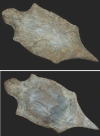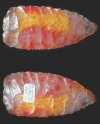|

Click to enlarge
|
A fine matched set of Mississippian limestone earspools from
Meigs County, Tennessee. They measure 3” across and both still retain some of
their original copper covering. These were found together by John Padgett in
the mid 1970s. Both spools are perforated through the center and have a classic
pulley attachment. They exhibit some decoration on the rims of their outer
faces. Matched pairs of earspools are extremely rare. Earspools first appeared
in the Woodland Period. During the Mississippian Period shell, fluorite and
even pottery were also utilized for ear ornamentation. Collection of Phillip
Helms, Decatur, Tennessee |

Click to enlarge
|
An undamaged and exceptional orange-red ferruginous quartzite
rectangular barreled banner from Georgia. This was found by Johnny Tomberlin in
July, 1995 while he worked as a diver on the Flint River, near the town of
Bainbridge. It measures 3 5/8 inches long by 2 1/2 inches wide. This style of
banner came very late in the Archaic Period. It has a fine polish, concave
wings and a full perforation.Collection of Dennis Bushey, Cullman, Alabama |

Click to enlarge
|
This ferruginous quartz Hourglass type bannerstone is a
distinct uniface style with a raised ridge on one side. It is made of orange,
gray and white quartzite and measures 2 7/16 inches in length, and 2 inches in
width, 13/16 inches in thickness. It features a tapered perforation drilled
with a hollow reed that varies from 12.5 mm to 13.55 mm in diameter. The
entrance of the perforation had a light pecked countersink on both entrances of
the perforation to facilitate the seating of the drilling substance. The
overall finish is finely polished with only tiny remnants of the pecking
process remaining that was required to finish the artifact. Many years ago, it
was acquired from John White, a professor of archaeology who with his family
lived in a dirt floor shack without windows at Kampsville, Illinois
archeological site while it was being excavated. Floyd Ritter acquired the
artifact from White, then it was acquired by Bobby Onken and more recently by
James Joe Kinker of Hermann, Missouri. It was twice illustrated in “Indian Life
in the upper Great Lakes” published 1960 by Quimby. Provenance listed on the
reverse side is Calhoun County, Illinois. Collection of Col. John F. Berner,
Roswell,Georgia |

Click to enlarge
|
A broken fragment of a monolithic axe found in 1937 near the
Coosa River, in Alabama. It is highly polished, made of greenstone and measures
ten inches long. There are less than thirty known examples of monolithic axes,
and several are fragments like this one. Collection of Scott McCreary, Desoto,
Missouri |

Click to enlarge
|
Above are top and bottom views of a fabulous ceremonial
Turtle flint effigy. It was discovered in 1977 in Stewart County Tennessee by
Pinky Wafford. Measuring 8 1/2 inches in length, it is undamaged and very
finely made from a dark brown Dover chert. It was laying in about six inches of
water at the edge of Standing Rock Creek. There was a strap handle bowl sitting
on top of it, which stained the turtle, as can be seen in the bottom
photograph. Inside the bowl were four small clay effigy figurines, one of which
was a duck. Large flint animal effigy figurines are extremely rare. It should
be noted that two similar effigy turtle effigy ceremonials were found with the
fabulous “Duck River Cache” in 1894, now housed in the McClung Museum at the
University of Tennessee in Knoxville. Collection of Ronald K. Knight, Signal
Mountain, Tennessee |

Click to enlarge
|
Pictured above are both sides of a wonderful and colorful
blade from Western Colorado. It was found during road construction in the town
of Cortez, by Bob Leighton in 1964. It is made from a material locally known as
“pigeon blood agate.” It is exceptionally thin and measures 4 1/4 inches long
by 1 5/8 inches wide. These blades are sometimes referred to as a “Folsom
ultra-thin”. It may be Paleo in origin, or possibly from the one of the Archaic
“basket-maker” cultures that inhabited prehistoric Colorado. Collection of Jim
Crawford, St. Louis, Missouri |

Click to enlarge
|
This 4 ˝ inch wide red sandstone tablet is known as “The
Wilson Tablet.” A crosshatching design can be observed at the left side as well
as a group of three parallel lines across the center. At the right is an
undulating pattern which may be a snake or some other representation. This
design is similar to those found on “Ramey-Insized” pottery. While damaged and
showing some plow-marks from being found in a cultivated field, these kinds of
tablets are very rare. This was found in Madison County, Illinois, and is one
of the larger tablets known. It shows signs of once being in a very hot fire.
It is unique from the other tablets in that the cross-hatching shares the same
side as the design. Collection of Dennis Arbeiter, Godfrey, Illinois |

Click to enlarge
|
An exceptionally large and finely made blade made from a
pinkish white Burlington Chert. Measuring 8 inches long, this was found in 1924
near Clam Falls, in northwest Wisconsin. Collection of Dan Maas,
Stoddard,Wisconsin |
|
Copyright © C.S.A.S.I.
|




